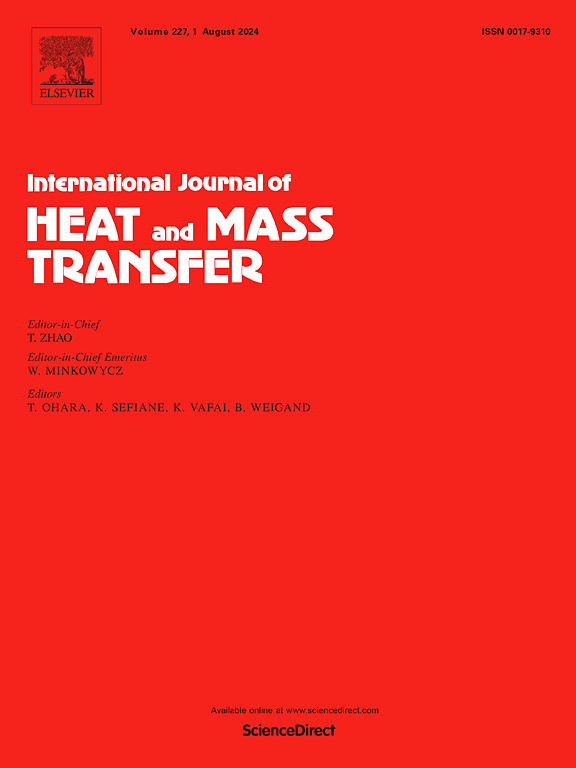Enhanced pool boiling of Novec-7100 using nano/micro structured surfaces
IF 5.8
2区 工程技术
Q1 ENGINEERING, MECHANICAL
International Journal of Heat and Mass Transfer
Pub Date : 2025-06-02
DOI:10.1016/j.ijheatmasstransfer.2025.127320
引用次数: 0
Abstract
Fluorinated dielectric liquids (e.g., Novec-7100) are critical for electronics cooling applications, for which engineered surface textures can dramatically improve pool boiling performance. This study presents a systematic comparison between two distinct surface engineering approaches: (1) nanostructured surfaces created via chemical vapor deposition and (2) microstructured surfaces fabricated using porous copper foam and copper mesh. Through controlled pool boiling experiments, the results showed that the introduction of micro and nanostructured surfaces effectively reduced the wall superheat at the onset of nucleate boiling due to the coupling between surface structure and bubble evolution, with microstructured surfaces improving heat transfer coefficient and critical heat flux by 61.9 % and 65.23 %, respectively, which is superior to the nanostructured surfaces due to the improvement in the liquid replenishment. The three-dimensional interconnected pore structure of copper foam provides optimal cavity sizes for bubble nucleation while simultaneously enhancing liquid replenishment through capillary action. High-speed visualization reveals that copper mesh surfaces exhibit 2-fold higher bubble departure frequency than plain surfaces, directly correlating microstructural features with enhanced bubble dynamics. These findings establish porous metallic structures with multiscale porosity as the optimal solution for maximizing both heat transfer coefficient and critical heat flux in dielectric fluid boiling applications. The study advances fundamental understanding of structure-performance relationships in phase-change heat transfer and offers practical surface engineering solutions for next-generation electronics cooling systems.
使用纳米/微观结构表面增强Novec-7100的池沸腾
氟化介电液体(例如novc -7100)对于电子冷却应用至关重要,工程表面纹理可以显着提高池沸腾性能。本研究对两种不同的表面工程方法进行了系统的比较:(1)通过化学气相沉积制造纳米结构表面;(2)使用多孔泡沫铜和铜网制造微结构表面。通过控制池沸腾实验,结果表明,由于表面结构与气泡演化之间的耦合作用,微结构和纳米结构表面的引入有效地降低了核沸腾开始时的壁面过热,微结构表面的传热系数和临界热流密度分别提高了61.9%和65.23%,优于纳米结构表面由于液体补充的改善而提高的传热系数和临界热流密度。泡沫铜的三维互联孔隙结构为气泡成核提供了最佳的空腔尺寸,同时通过毛细作用增强了液体的补充。高速可视化显示,铜网表面的气泡离开频率比普通表面高2倍,这直接将微结构特征与增强的气泡动力学联系起来。这些发现确立了具有多尺度孔隙度的多孔金属结构是电介质沸腾应用中传热系数和临界热流密度最大化的最佳解决方案。该研究促进了对相变传热中结构-性能关系的基本理解,并为下一代电子冷却系统提供了实用的表面工程解决方案。
本文章由计算机程序翻译,如有差异,请以英文原文为准。
求助全文
约1分钟内获得全文
求助全文
来源期刊
CiteScore
10.30
自引率
13.50%
发文量
1319
审稿时长
41 days
期刊介绍:
International Journal of Heat and Mass Transfer is the vehicle for the exchange of basic ideas in heat and mass transfer between research workers and engineers throughout the world. It focuses on both analytical and experimental research, with an emphasis on contributions which increase the basic understanding of transfer processes and their application to engineering problems.
Topics include:
-New methods of measuring and/or correlating transport-property data
-Energy engineering
-Environmental applications of heat and/or mass transfer

 求助内容:
求助内容: 应助结果提醒方式:
应助结果提醒方式:


